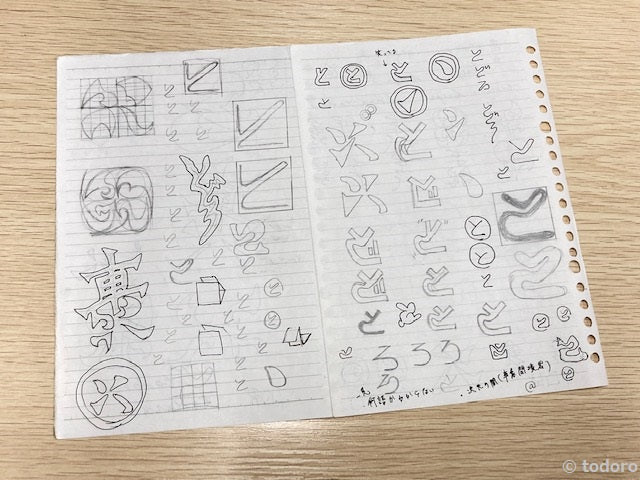
ロゴの話 / The logo story
Share
こんにちは。平岡です。
todoroのロゴについて書きます。
結論から書くと、todoroのロゴはひらがなの「と」になっています。
ブランド名を、日本語のような外国語のような、一見よくわからないものにしたかったように、ロゴに関しても、絵のような記号のような文字のような、よくわからないものにしたい、と思っていました。
国外にも大好きな文化がたくさんありますが、やっぱりこの国で生まれたからか、日本が好きです。
日本の良くない部分も知っていますが、良い部分もたくさん知っています。
日本には最果ての地とも言われるように、この国独特のものがたくさんあり、それを活用して世界にアピールすることは、自分達が使える武器になると同時に、世界に対して日本の文化を広げることで恩返しのようになるのではないか、と思っています。
ひらがなも日本が誇る独特の文化の1つです。
カタカナもそうですが、ひらがなを使う国は世界に1つしかありません。
カタカナと比べても、ひらがなというものは丸みを帯びていて、女性的で、やまとことばの象徴でもあり、極めて日本的です。
日本国外の人にも、その名を呼んでもらう以上はtodoroをアルファベット表記とすることは譲れなかったのですが、ひらがなをロゴにすることで勘弁してもらおうと考えました。

グラフィックデザイナーの大家、亀倉雄策さんが著書の中で、1970年頃の日本は、いわゆるあからさまに日本風と一目見てわかるものに頼っていた部分があると指摘しています。
歌舞伎の隈取りや浮世絵などが、それにあたるのではないかと思います。
そして当時国外でも、文化的背景を理解されることもないままに、一見していわゆる日本的だと認識されるものしか求められず、歯がゆい思いをした方も多かったようです。
これは、例えば歌手になりたいアイドルが、歌を歌うことを制限され、アイドルとしての立ち位置をスポンサーから求められるようなもので、文化の表現者としては、とても辛いことです。
いつか、表面的な日本文化に頼らない日本のデザインが世界に出ていくことを亀倉さんは期待されていたようです。
todoroとしても、安直に、「どや、日本やで」という表現をすることは避けたいなと思いました。
ちなみに亀倉さんはグラフィックデザイン界のスーパースターですが、光栄なことに僕は亀倉さんと下の名前が全く同じなのですが、これは全くの偶然です。
僕は家紋のデザインや思想が面白くて好きなので、ロゴは家紋のようなデザインにしたいと思っていました。
日本には、何百年も同じ屋号で商いを続けている人たちがたくさんいて、家紋がそのまま屋号として使われている場合も少なくありません。
レタリングやグラフィックデザインも好きなため、必ずその思想をロゴに取り入れようと思っていました。
レタリングに関しては、どのくらい好きかというと、小学生の時に兄の美術の教科書を借りて、手書きで明朝体が書けるようになるまで練習したくらい好きです。

上の写真2枚はロゴデザインのために、たくさん書き殴ったものの一部です。
最終的には、とどろの頭文字である「と」の字を数値で定義して図案化しました。
ひらがなの面白いところは、なめらかな曲線で表されるため、定規を使うとうまく書けず、二度三度と書いてもなかなか同じ形状に書くのが難しく、それがまた味や面白みを生むところです。
対して自分が身を置く工業の世界は、最終使用者が使用する際にブレが出ないよう、管理された一定の品質のものを生み出すことを求められる世界。
それをロゴで表現したいと考えました。
ひらがなと数値を組み合わせる、という考え方です。
前者は芸術の世界であり著作権で保護されますが、後者は工業の世界で特許権や意匠権で保護されます。
todoroでは、ものを作るものだけが知っているインダストリアルデザインの世界観をとても大事にしています。
工業の世界ではCADという製図用のアプリケーションを使うため、ロゴデザインはCADで行いました。
IllustratorやPhotoshopではなく、CADで作られたロゴというところがまたtodoroの特徴かもしれません。
下の画像はCADで作図する画面で、定義を示すイメージです。

ロゴは自分で商標権の登録を行い、無事に第6244096号として登録されました。
こうして、「と」の字のような、矢印のような、うさぎのような、何かが笑っているような形のロゴが生まれました。
ところで、家紋は、よくその形を元にした呼び方が付きます。
例えば、めんつゆのヤマキは、山の形をした記号の下にカタカナの「キ」で、ヤマキ、と呼びます。
todoroのロゴは「と」に「丸」なので、「止まる」になってしまいます。
これでは縁起が悪いので、「とまる」とは呼ばず、どこまでも止まることなく轟くよう「とどろ」と呼んでください。
くれぐれも止まることなく進んでいこうと思います。
Hi, this is Yussa.
I described todoro's logo in detail.
From the conclusion, the todoro logo is hiragana "to(と)".
Just as I wanted the brand name to be something that I didn't understand at first glance, like a foreign language like Japanese, I wanted to make the logo something that I didn't understand, like letters like pictures like symbols.
There are many cultures I love abroad, but I like Japan probably because I was born in this country.
I know the bad parts of Japan, but I also know many good parts.
As it is said that Japan is the far east place, there are many things unique to this country, and using them to appeal to the world will be a weapon that we can use, and at the same time, we will bring Japanese culture to the world. I think that expanding it will be like giving back.
Hiragana is also one of the unique cultures that Japan is proud of.
As with katakana, there is only one country in the world that uses hiragana.
Compared to katakana, hiragana is rounded, feminine, and a symbol of Yamato language, and is extremely Japanesy.
I had to use the alphabetical notation of todoro to be called our name from people outside of Japan. But I thought I'll show my love to Japan me by using the hiragana logo.

In his book, a master of graphic designer KAMEKURA Yusaku points out that Japan around 1970 relied on what was so-called Japanese style which is found at a glance.
I think that Kabuki's Kumadori and Ukiyo-e are examples of this.
At that time, even overseas, many people felt impatient. Because they were only asked for something that seemed to be so-called Japanese style which is found at a glance, without understanding the cultural background.
This is like, for example, an idol who wants to be a singer is restricted from singing songs and is asked by a sponsor to being as an idol, which is very painful for a artist who expresses a culture.
It seems that Mr. Kamekura was expected that someday, Japanese design that does not rely on superficial Japanese culture will appear in the world.
Even for todoro, I wanted to avoid using the expression "WE ARE THE JAPAN" in a straightforward manner.
By the way, Mr. Kamekura is a superstar in the graphic design world, and I'm honored to have the exact same name as Mr. Kamekura, but this is a complete coincidence.
I like the design and ideas of the family crest, so I wanted the logo to look like a Japnaese traditional family crest.
In Japan, there are many people who have been doing business under the same name for hundreds of years, and it is not uncommon for the family crest to be used as it is.
I also like lettering and graphic design, so I always wanted to incorporate that idea into my logo.
As for lettering, I like to borrow my elder brother's art textbook when I was in elementary school and practice until I can write Japanese traditional font Mincho style by hand.

The above two pictures are some of the ones I wrote a lot for the logo design.
In the end, I defined the character "to(と)", which is the acronym for Todoro, numerically and made it into a design.
The interesting thing about hiragana is that it is represented by a smooth curve, so it is difficult to write it well with a ruler, and it is difficult to write it in the same shape even if you write it twice or three times, which also creates taste and fun.
On the other hand, the industrial world in which I live is a world where it is required to produce products of a certain quality that are controlled so that there will be no unevenness when the end user uses it.
I wanted to express it with a logo.
The idea is to combine hiragana and numerical values.
The former is in the art world and is protected by copyright, while the latter is protected by patents and design rights in the industrial world.
At todoro, we value the world of industrial design, which only those who make products know.
In the industrial world, CAD is used for drafting applications, so I designed the logo with CAD.
Another feature of todoro may be that it is a logo made with CAD instead of Illustrator or Photoshop.
The image below is a screen drawn by CAD and is an image showing the definition.
The logo was registered as a trademark right by myself and was successfully registered as No. 6244096 in Japan.
In this way, a logo that looks like a "to(と)", an arrow, a rabbit, or something laughing was born.

The logo was registered as a trademark right by myself and was successfully registered as No. 6244096 in Japan.
In this way, a logo that looks like a "to(と)", an arrow, a rabbit, or something laughing was born.
By the way, Japanese traditional family crests are often called based on their shape.
For example, Yamaki which is famous as a seasoning maker uses logo which is a katakana "ki(キ)" under the mountain-shaped symbol. Mountains are calles "yama" in Japan.
The todoro logo is "to(と)" and "circle". Circles are called "maru" in Japan. So it will be "stop". "tomaru" means "stop" in Japan.
This is unlucky, so don't call us "tomaru", but call us "todoro" to extend us endlessly without stopping.
We will continue to move forward without stopping.